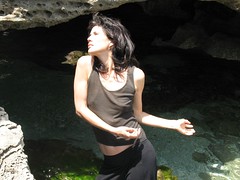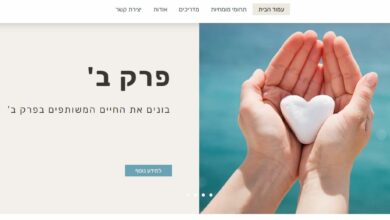השימושון
בוטו ; ריקוד הנפש עם טינה ואן דר וורפ
 ריקוד הבוטו נולד ביפן שנת 1959. שני אנשים, קזואו אונו וטאצומי היג'יקטה, חקרו את הריקוד במשך שנים רבות, מהמסורתי היפני, דרך המערבי המודרני ועד הגרמני האקספרסיוניסטי, ועדיין, הם חיפשו משהו יותר אותנטי, משהו שיביע נכון יותר את גופם ונשמתם.
ריקוד הבוטו נולד ביפן שנת 1959. שני אנשים, קזואו אונו וטאצומי היג'יקטה, חקרו את הריקוד במשך שנים רבות, מהמסורתי היפני, דרך המערבי המודרני ועד הגרמני האקספרסיוניסטי, ועדיין, הם חיפשו משהו יותר אותנטי, משהו שיביע נכון יותר את גופם ונשמתם.
השניים הניחו בצד הדרך את כל שלמדו, את כל הטכניקות שצברו והכל בכדי לתת למשהו חדש להופיע, ריקוד הנובע ממעמקי גופם. והוא אכן הופיע, הם קראו לו – בוטו, שפירושו ביפנית ריקוד הרקיעה. בניגוד לריקוד המערבי השואף לאוויר, דרך קפיצות וירטואוזיות לגבהים, מרכז הבוטו באדמה.
אונו והיג'יקטה קיבלו השראתם מכח הטבע, רחש הרוח, העצים, הדשא, הגשם, החרקים והחיות. אונו היה בן 53 בעת שנולד הבוטו והוא לימד בוטו עד לאחרונה. אונו חי ביפן והוא בן 102 שנה. בנו, יושיטו אונו מלמד בוטו ביפן.
נקודת המוצא של הבוטו בהיות הרקדן במקום רגוע, מצוי בתודעת קבלה. במצב זה הרקדן הוא ככלי ריק לריקוד המתגלה בו ומתגלם ממנו במלוא הדרו. כאן מתחיל המסע. המסע אל תוככי העצמי.
הריקוד הוא ללא מטרה, ללא הישג, ללא מושג. להיות אחד עם הרגע הזה. מה שמופיע הוא לעולם מסתורין. הריקוד יכול להיות יפה או מכוער, חינני או מגוחך, שמח או כואב, הבוטו מאפשר מקום לכל אלה – לכל מבעי פני האדם, לכל מניפת קשת הרגשות. ובכך שונה הבוטו משיטות ריקוד אחרות ששואפות לאסתטי.
על כן הבוטו הנו כלי מרפא, הוא מאפשר לרקדן לצלול למעמקי הרגש והתחושה ולהביעם דרך התנועה. בוטו הנו ריקוד הנפש או, מעשה ההקשבה לנפש, והכל רק בכדי לאפשר לנפש לרקוד.
טינה ואן דר וורפ נולדה וגדלה ביפן לאמא יפנית ולאבא הולנדי. "כילדה תמיד נמשכתי לריקוד אך לא למדתי ריקוד. מאוחר יותר השתתפתי במספר שיעורי ריקוד מודרני אך היה לי ברור שזה לא מה שאני רוצה ללמוד, בעיני זה היה יותר מדי תחרותי, להיות תמיד הכי גמישה הכי אלגנטית.
ב 1994 הלכתי להופעה בטוקיו של קבוצת בוטו – סאן קאי ג'וקו. נדהמתי. מה זה היה? כה מסתורי, מעבר להבנה. לאחר חוויה זו רציתי ללמוד בוטו. למדתי אצל טורו אייוואשיטה, רקדן להקת סאן קאי ג'וקו. להפתעתי לא היה צריך כל ידע מוקדם בריקוד. בשיעורים לא למדנו טכניקה אלא להפך – זניחת הטכניקות. טורו סיפר לי כי הוא העביר שיעורי בוטו במוסדות לחולי נפש וכי הבוטו הנו כלי טיפולי. זה היה בשבילי מדהים שכן תמיד התעניינתי בפן הטיפולי של הריקוד.
ב 1999 הגעתי לישראל והמשכתי ללמוד בוטו במשך 6 שנים אצל מאיה דונסקי. בתחושתי מאיה הייתה כמיילדת – מאפשרת לי ללדת את הריקוד שלי. בשנים האחרונות אני מעבירה שעורי בוטו. לאחר שלמדתי דמיון מודרך התחלתי לשלב כלי עוצמתי זה בשיעורי הבוטו שאני מעבירה ובכך מאפשרת לתהליך הטיפולי הטבוע בבוטו להעמיק.
 הבוטו עזר לי מאד להנות מהיות עצמי בתוך גופי, להנות מתנועת גופי, להנות מהריקוד העובר דרך גופי. הבוטו עזר לי להכיל ולחוות את כל אלה מהמקום העמוק ביותר שבי. זו בשבילי זכות גדולה ואושר להעביר זאת הלאה את החוויה של עשיית שלום עם גופי והכרתי.
הבוטו עזר לי מאד להנות מהיות עצמי בתוך גופי, להנות מתנועת גופי, להנות מהריקוד העובר דרך גופי. הבוטו עזר לי להכיל ולחוות את כל אלה מהמקום העמוק ביותר שבי. זו בשבילי זכות גדולה ואושר להעביר זאת הלאה את החוויה של עשיית שלום עם גופי והכרתי.
אני מזמינה אנשים לגלות עונג הריקוד ועונג תנועת הגוף והנוכחות בגוף, לפגוש כל מצב רגשי הנמצא כרגע, בהווה.
בשיעוריי אני עושה שימוש רב בדימויים ומוסיקה מהטבע. בוטו הוא מדיטציה. מבט הבוטו פנימה, לא עוד החוצה. לצלול, להביט פנימה ולדלות את האוצרות – נעימים או כואבים – עולם ומלואו ממתין להתגלות בתוכך, ולהיות מובע דרככם.
המפגשים בימי שלישי מ 22:30 – 20:30 בסטודיו באביאל | 6402010 -052 | מייל
for english
Butoh dance originated in Japan in 1959 by two men, Kazuo Ono and Tazumi Hijikata. After years of studying dance (from Western dance to Japanese traditional dance, to German Expressive dance) they felt they were still searching for something else. They were looking for something more authentic, something that better expressed their bodies and their souls. Thus they put aside all technique, and allowed the dance to come from deep inside the body. They named this dance Butoh- literally meaning "dance step" or "stamping dance". This was opposed to western dance that was much about leaping into the air and being high. The dance that arose from them was of the ground, of the earth. Ohno and Hijikata were very inspired by nature and the movements of the wind, of trees, of grass, of insects, of animals, and of rain. Ono was 59 when the butoh dance was
born, and he went on to perform and teach this for many years.
The dancer in a deeply relaxed state, a receptive state, is the starting point of Butoh. The dancer becomes an empty vessel for the dance to be revealed. This is the starting point of the journey into the self. The dance is without any goals. It is about becoming one with the moment. What arises from there is a mystery. The dance can be beautiful or ugly, graceful or absurd, joyous or painful. Butoh allows expression to all faces of the human. In this, it is different from other dances that strive to be only esthetic or beautiful or graceful. Butoh embraces all sides. Thus it is very healing. It allows one to dive into the depths of a feeling and express it through movement. Butoh is the dance of the soul, or rather it is the act of listening to the soul, and allowing the soul to dance.
Tina vanderworp was born and raised in Japan to a Japanese mother and Dutch father. As a child I had always been drawn to dance but never studied any kind of dance. In later years I tried a few classes of modern dance but felt that that was not what I was looking for. It seemed to be a very harsh and competetive world much about how fast or flexible or graceful you were. In 1994 in Tokyo, I went to a performance by the Butoh dance group- sankai juku. I was mesmerized. What was this dance? It seemed to be something so mysterious and beyond description. I then went on to study with Tooru Iwashita- a dancer of Sankai Juku. I was so surprised to discover that his workshops were open to everyone. His lessons were not about technique. They was about throwing away all technique. Iwashita told me that he taught Butoh to patients in mental hospitals and that it was very therapeutic. I was fascinated as I have always been interested in the therapeutic side of dance.
In 1999 I came to Israel and continued to study Butoh for the next 6 years with Maya Dunsky. I felt that Maya was like a midwife- helping us to give birth to our own dance. In recent years I started to teach Butoh. After studying Guided Meditation I have started to integrate that into my Butoh classes making it into a deep healing experience. Butoh has helped me to enjoy being inside my body, enjoy moving my body, enjoy dance through my body. Im so happy to pass this on to others- to pass on the experience of making peace with your body and mind. I invite people to come to my Butoh class and discover the joy of dance, the joy of moving their bodies, the joy of just being present inside their bodies. I invite people to meet whatever mood of emotion is present. I often use images from nature and music from nature in my Butoh classes. Butoh is meditation. Butoh is about looking within. It is not about looking outside anymore. It is about looking within and discovering the treasures- pleasant or painful. A whole universe is waiting to be discovered inside of you- and to be expressed through you.
Tuesdays 22:30 – 20:30 at Aviel | 6402010 -052 | e-mail
.



שלום שלום
ביום שישי הבא, 30 ליולי,
מ 10 בבוקר עד 12:30
יש סדנת בוטו בסטודיו באביאל.
כרגע אין סדנאות בת"א
אשמח מאד לראותכם
טינה ואן דר וורפ
052-6402010
האם ממשיכים השיעורים בתא. ,תודה ברוריה
שלום לך
אשמח לדעת יותר פרטים על שיעורי בוטו בתל אביב
רות
הי גלית,
מצטערת על התגובה המאוחרת.
לפני שבוע חזרתי מיפן. ביפן פגשתי את קזואו אונו. זו הייתה חוויה מדהימה לפגוש את האדם שכה השפיע על חיי. חוויה גדולה ומעצימה הייתה גם ללמוד מבנו, יושיטו אונו, מאסטר, איש צנוע ומקסים.
חזרתי לארץ מלאת מוטיבציה. אני מלמדת בסטודיו קסום באביאל בימי שישי מ 10 עד 12 ורבע ובקרוב תפתחנה קבוצות חדשות באביאלו בת"א. מוזמנת בחום. טינה 052-6402010.
הי טינה! שמחתי מאוד להכיר אותך היום. המאמר שלך מקסים! אומר הכל… השיעורים הם גם באוגוסט או שאת בחופש?